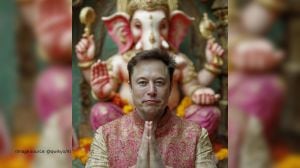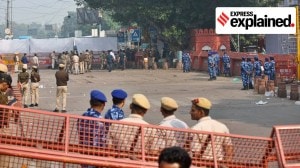Shubhajit Roy, Diplomatic Editor at The Indian Express, has been a journalist for more than 25 years now. Roy joined The Indian Express in October 2003 and has been reporting on foreign affairs for more than 17 years now. Based in Delhi, he has also led the National government and political bureau at The Indian Express in Delhi — a team of reporters who cover the national government and politics for the newspaper. He has got the Ramnath Goenka Journalism award for Excellence in Journalism ‘2016. He got this award for his coverage of the Holey Bakery attack in Dhaka and its aftermath. He also got the IIMCAA Award for the Journalist of the Year, 2022, (Jury’s special mention) for his coverage of the fall of Kabul in August 2021 — he was one of the few Indian journalists in Kabul and the only mainstream newspaper to have covered the Taliban’s capture of power in mid-August, 2021. ... Read More
PM Modi in Bhutan: How ‘K4’, the fourth king, managed Thimpu’s ties with Delhi for over 30 years
PM Modi Bhutan visit, India-Bhutan relations: PM Modi is in Bhutan to attend the 70th birthday celebrations of Jigme Singye Wangchuck, the father of the incumbent king. Here's how ties between the two nations progressed under him.
 PM Modi Bhutan visit: PM Modi with Bhutan King Jigme Khesar Namgyel Wangchuck (left) and his father Jigme Singye Wangchuck, during an event to mark the latter’s 70th birthday, in Thimphu. (X/@MEAIndia via PTI)
PM Modi Bhutan visit: PM Modi with Bhutan King Jigme Khesar Namgyel Wangchuck (left) and his father Jigme Singye Wangchuck, during an event to mark the latter’s 70th birthday, in Thimphu. (X/@MEAIndia via PTI)PM Modi Bhutan visit: Prime Minister Narendra Modi is in Bhutan to attend the 70th birthday celebrations of the fourth king of Bhutan, Jigme Singye Wangchuck, the father of the incumbent king, Jigme Khesar Namgyel Wangchuck.
Modi said on Tuesday, “The life of His Majesty The Fourth King of Bhutan is a combination of Wisdom, Simplicity, Courage, and Selfless Service to the Nation. He took on a great responsibility at just 16 years of age. He gave his country fatherly affection and led it forward with a vision. During his 34-year reign, he carried forward both Bhutan’s heritage and development…His Majesty has also played a vital role in strengthening the friendship between India and Bhutan. The bond between our two countries continues to grow on the foundation he laid.”
Popularly known as K4, Jigme Singye Wangchuck became the king of Bhutan — ‘Druk Gyalpo’, or the Dragon King in Dzongkha language — in 1972 at the age of 16, when his father, King Jigme Dorji Wangchuck, passed away.
In his tenure of over 30 years, K4 interacted with 12 Indian Prime Ministers, from Indira Gandhi to Rajiv Gandhi to Atal Bihari Vajpayee to Dr Manmohan Singh, till he abdicated the throne in 2006 for his son. He also took the bold step of converting the hereditary monarchy to a constitutional monarchy and turning Bhutan into a democracy by 2008.
Early years, early bonds with India
When Jigme Singye Wangchuck ascended the throne as a teenager, he did not come unprepared. His father had appointed him as the Chairman of the Planning Commission in 1971, which planned and coordinated Bhutan’s five-year plans.
These plans had been launched with the help of Prime Minister Jawaharlal Nehru in 1961, modelled on India’s Five-year Plans.
Thus, Jigme Singye’s first official role not only gave him an exposure to governance, it also made him understand the Indian government’s financial support and the intricacies of the discussions on hydro-power projects then underway between the two countries. He also developed a good rapport with Indira Gandhi.
In 1974, he took the decision of pegging the Bhutanese currency to Indian rupee in consultation with Indira Gandhi. Indian officials say that he oversaw the introduction of the Ngultrum (Bhutanese currency) and kept it pegged 1:1 to the Indian rupee, minimising foreign exchange risks and making day-to-day trade with India seamless.
Very early, he took the call to strengthen Bhutan’s relationship with India and decided to be in constant touch with key stakeholders — important leaders of Assam, West Bengal and Odisha, and senior government officials in Delhi.
Oversaw Bhutan’s opening up to the world
Besides deepening ties with India, he also engaged with the world.
While Bhutan became a member of the UN in 1971, under his reign, diplomatic ties were developed with Bangladesh (1973), Kuwait and Nepal (1983), Maldives (1984), Denmark, Norway, Sweden, Switzerland and Netherlands (1985), Japan and Finland (1986), South Korea and Sri Lanka (1987), Austria (1989), Thailand (1991), Bahrain (1992), Singapore and Australia (2002) and Canada in 2003.
He kept India well-informed about Bhutan’s ties with other countries, including with its northern neighbour, China. Taking Indira Gandhi and later Rajiv Gandhi into confidence, he decided to start border negotiations with China in 1984.
He also coordinated with Rajiv Gandhi as SAARC was established, and went to Dhaka in 1985 as one of the founding members. This made a big difference to Bhutan’s image.
Hydro-power coordination
Under Jigme Singye, cooperation with India on hydro-power projects really took off, which has proved a success for both countries.
The agreement for a 336-MW power project in Chukha was signed in 1974. The king led the commissioning of Bhutan’s first mega hydro-electric project with India on a 60 per cent grant and 40 per cent loan model.
The Chukha project was formally inaugurated during Rajiv Gandhi’s tenure in October 1988. Then President R Venkataraman attended the ceremony, kickstarting the process of power export to India.
The power projects continued through the 1990s, when India had various coalition governments. The NHPC built the 60 MW Kurichhu Hydropower project during PM Atal Bihari Vajpayee’s tenure in 2001–02. This helped power-scarce eastern Bhutan and exported surplus power to India.
The cooperation continued in the Manmohan Singh era, when the Tala Hydropower (1,020 MW) project was executed and a long-term energy deal signed.
Role in ‘Operation All Clear’
Jigme Singye also helmed security cooperation with India in flushing out militants from Bhutanese soil in 2003-04, when Vajpayee was PM.
This was the time when militant groups active in northeastern India, like the United Liberation Front of Asom (ULFA), National Democratic Front of Boroland (NDFB) and the Kamtapuri Liberation Organisation (KLO), had set up camps across the border in Bhutan and were using them as safe havens.
In close consultation with then NSA Brajesh Mishra, K4, as Supreme Commander, led Bhutan’s first military operation to dismantle the militant camps. India sealed the border and provided logistical support to the Bhutanese troops, marking a watershed in bilateral security cooperation.
“On 15th December 2003, the 4th King, in the fashion of a classical leader led the Bhutanese offensive to flush out the militants. The Bhutanese attack was swift and well-coordinated…some 35 camps were routed and 485 insurgents flushed out into India where the Indian security forces waited to arrest them…,” author Karma Phuntso wrote in his 2013 book, The History of Bhutan.
Guiding hand
While K4 abdicated the throne in 2006, he negotiated with Manmohan Singh on the India-Bhutan Friendship Treaty of 2007, which upgraded the 1949 India-Bhutan Treaty of Friendship to reflect modern realities.
The 1949 treaty had said that Bhutan would be guided by India in conducting its external affairs. Bhutan’s democratic transition paved the way to replace this clause with a modern mutual-cooperation framework in the 2007 agreement.
Even after making way for the fifth king, K4 has been the “guiding hand” for India-Bhutan ties, as senior leaders and officials in the strategic establishment keep up engagement with him. His counsel is valued by both the Bhutanese government and the current king, especially when it comes to strategic issues of shared concern for India and Bhutan.



- 01
- 02
- 03
- 04
- 05




































